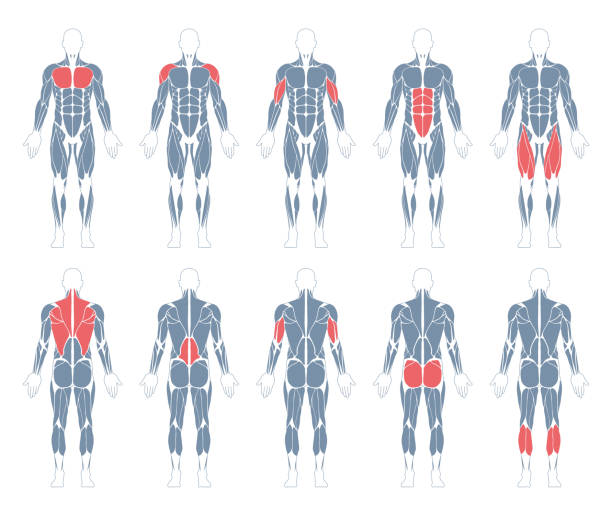
Understanding the Deltoid Muscles
The deltoid muscles are an important muscle group in our bodies that help us perform various activities, especially those that involve our shoulders. We will discuss what deltoid muscles are, their anatomy, and why they are essential.
Deltoid muscles are a group of three muscles that form the rounded shape of our shoulders. These muscles are located on the uppermost part of our upper arm, and attach to the shoulder blade and collarbone. They are called deltoid muscles because they are shaped like a delta, a triangle representing the Greek letter delta.
The deltoid muscles are divided into three parts: the anterior (front), medial (middle), and posterior (back) deltoids. Each part of the deltoid muscles is responsible for different movements. The anterior deltoid helps us lift our arms in front of our bodies, the medial or middle deltoid helps us lift our arms out to the sides, and the posterior deltoid helps us pull our arms behind our bodies.
Apart from their shape and location, deltoid muscles are unique because they allow us to perform a wide range of shoulder movements. We use our deltoid muscles when lifting weights, throwing a ball, reaching for something on a high shelf, or even brushing our hair. These shoulder muscles are so important that they are used in almost every upper-body movement we make.
It is also essential to know that our deltoid muscles work with other muscles in our shoulders, such as the rotator cuff muscles. Together, these muscles help stabilize our shoulder joints and prevent injuries.

The Importance of Deltoid Workouts
1. Why You Should Add Deltoid Exercises to Your Shoulder Workouts
The first reason to add deltoid exercises to your child’s shoulder workouts is that many workout routines often neglect these muscles. As a result, the deltoids can become weak and unable to do their job correctly, leading to injury or discomfort. Focusing on these muscles increases their strength and flexibility, which is essential for maintaining shoulder joint and health and overall fitness.
2. Why Deltoid Workouts Are Important
Deltoid workouts are also essential because they contribute to better posture and a more positive mindset. As these muscles strengthen, your child can naturally stand taller, which improves their overall posture, making them feel and look more confident. Additionally, when we exercise, our brain releases endorphins, which can help boost our mood and reduce stress, providing a positive mindset.
3. Strengthen Your Upper Body and Prevent Injuries
Deltoid workouts also help to strengthen the entire upper body and can help prevent injuries. By strengthening the deltoids, your child can lift heavier weights safely, which can help prevent injuries from lifting items with poor form or carrying heavy backpacks, for example. When we take care of our muscles through regular exercise, we’re helping to protect our body from injury.
4. Better Posture and a Positive Mindset
As mentioned earlier, deltoid workouts can improve posture, which can help prevent back pain and other conditions. Good posture also means better breathing, which is essential for cardiovascular health. When we breathe correctly, we provide our muscles and organs with appropriate oxygen, improving overall physical health.
5. How to Add Deltoid Workouts to Your Routine
If your child is new to working out, deltoid exercises are the perfect addition to their routine. Some exercises great for working the deltoids include overhead presses, lateral raises, and front raises. Start with lighter weights and work up as their strength increases. Remember, it’s better to do fewer reps with good form than more reps with poor form. Finally, always warm up and stretch before working out to prevent injury.

17 Deltoid Exercises
The deltoid muscles are located on your shoulders and consist of three parts – the anterior, medial, and posterior. These muscles are responsible for lifting and rotating your upper arms and giving your shoulders a toned, defined look. We’ll discuss the best deltoid exercises you can do at home or in the gym.
1. Dumbbell Shoulder Press:
The dumbbell shoulder press is one of the best exercises for targeting the entire shoulder region, including the deltoids. To perform this exercise:
- Sit on a bench with your back straight and your feet flat.
- Hold a dumbbell in each hand, and raise the weights to your shoulders.
- Push the weights above your head, extending your arms fully before slowly lowering the weights back down to shoulder level.
- Repeat for a set of 10-12 reps.
This exercise is great for building strength and size in your deltoids.
2. Neutral Grip Shoulder Press:
The neutral grip shoulder press is a variation of the dumbbell shoulder press that places more emphasis on the front deltoids. To perform this exercise:
- Sit on a bench with your back straight and your feet flat.
- Hold a dumbbell in each hand with a neutral grip (palms facing each other).
- Raise the weights to shoulder level, then push the weights up above your head, extending your arms fully before slowly lowering the weights back down to shoulder level.
- Repeat for a set of 10-12 reps.
3. Seated EZ Bar Underhand Press:
The seated EZ bar underhand press is an excellent exercise for targeting the rear deltoids. To perform this exercise:
- Sit on a bench with your back straight and your feet flat.
- Hold an EZ bar with an underhand grip (palms facing up) and lift the barbell to chest height.
- Push the bar up and over your head until your arms are fully extended, then slowly lower the bar back down to chest height.
- Repeat for a set of 10-12 reps.
4. Neutral Grip Front Raise:
The neutral grip front raise is a great exercise for targeting the front deltoids. To perform this exercise, stand with your feet shoulder-width apart, holding a dumbbell in each hand with a neutral grip. Raise the weights straight out in front of you until your arms are parallel to the floor, then slowly lower them back down to your sides. This exercise is great for toning and sculpting your deltoids.
5. Bent Over Lateral Raise (Reverse Fly):
The bent-over lateral raise, also known as the lateral raise stand the reverse fly, is a great exercise for targeting the medial deltoids. To perform this exercise:
- Stand with your feet shoulder-width apart, holding a dumbbell in each hand.
- Bend over at the waist until your chest is parallel to the ground, keeping your back straight.
- Raise the weights to your sides until your arms are parallel to the ground, then slowly lower them back down to your sides.
- Repeat for a set of 10-12 reps.
6. Lateral Raise:
The lateral raise is a classic shoulder exercise. Stand with your feet shoulder-width apart and hold a pair of dumbbells down at your sides. Lift the dumbbells out to the sides until they reach shoulder level. Lower the weights slowly and repeat. This exercise targets the side deltoid muscles and helps in building strong shoulders.
7. Upright Row to Hip Fly:
This exercise combines two moves: the upright row and the hip fly. Begin by holding a pair of dumbbells and bringing them up to your chest, close to your body. Keep your elbows close to your body and lift the weight towards your chin. Then lower the weight down and raise your your arms straight out to the side. This exercise helps in building upper and lower deltoid muscle strength.
8. Standing Arnold Press:
Named after Arnold Schwarzenegger, the standing Arnold press is an excellent exercise for beginners. Arnold press works all three heads of the deltoid muscles. Begin by holding a pair of dumbbells in front of your chest with your palms facing your body. Then, lift the dumbbells and press them overhead. Lower the weights back to chest level and repeat.
9. Single Arm Cross Body Front Raise:
This exercise targets the anterior deltoid muscle, the front of your shoulder. Hold a dumbbell in your right hand and extend your left arm straight in front of you. Lift your arm and move it across your chest, pause, then slowly lower it. Repeat on the left side. This exercise will strengthen the front deltoid muscles in each shoulder.
10. Single-Arm Dumbbell Press:
This exercise is ideal for beginner-level training. Begin by holding a dumbbell weight at your chest level in one hand. Push the weight up overhead while keeping your back straight. Return the weight to your chest level and repeat on the other arm. This exercise builds shoulder strength and size.
11. Balanced Side Lunge with High Pull:
This exercise is a little more advanced and requires balance. Start by holding a dumbbell in your left hand. Step your right foot to the side into a lunge, dropping your hips down. . Stand with feet hip back up and lift the dumbbell up and to the side of your shoulder. Repeat on the other side. This exercise targets the muscles in your outer deltoids and requires stability and balance.
12. Rear Delt Fly:
This exercise targets the rear deltoids, often neglected but important for overall shoulder strength. Sit on a bench and hold a weight in each hand. Lean forward with elbows slightly bent, raise your arms to the side, and squeeze your shoulder blades together. Pause, then lower the weights slowly. Repeat.
13. Dumbbell Upright Row:
This is another excellent exercise for beginner-level training. Start by holding a weight in each hand and keeping your palms facing down. Lift the weights to your chest, keeping your elbows above your hands. Lower the weights slowly and repeat. This exercise targets the middle and upper part of your posterior deltoid muscles only.
14. Dumbbell Lateral Raise:
First up, we have the dumbbell lateral raise. This is a simple exercise that can be done even at home. You need a pair of light dumbbells. Start with standing straight, arms by your sides, and palms facing your thighs. Slowly lift your arms to the side, keeping them straight and parallel to the floor. Pause for a moment before lowering them back down. Try to do 3 sets of 10 to 12 repetitions. This exercise targets your side deltoids and helps build broader shoulders.
15. T Push-Up:
Next, we have the T push-up. This variation of the standard push-up will work your entire upper body, especially your front and rear deltoids. Start with getting into a push-up position. Lower yourself down as usual, but as you push back up, lift one arm towards the ceiling until it’s perpendicular to your upper body exercises back. Keep your eyes on your raised hand to avoid neck strain. Return to your starting position and alternate arms. Try to do 3 sets of 8 to 10 repetitions.
16. Face Pull:
Our third exercise is the face pull. You will need a resistance band or a cable machine for this one. Start by standing with your feet shoulder-width apart, holding the band or handles at chest or shoulder height only. Pull the band towards your face, tucking your elbows in and squeezing your shoulder blades together. Pause for a moment before releasing back to the starting position. This exercise works your rear deltoids and upper back. Try to do 3 sets of 12 to 15 repetitions.
17. Front Raise:
The fourth exercise is the front raise. Like the dumbbell lateral raise, this exercise focuses on your front deltoids. Start by standing straight, your feet hip width apart, holding a dumbbell in each hand, palms facing in. Slowly lift the weights before you, keeping them in line with your shoulders. Pause for a moment before lowering them back down. Try to do 3 sets of 10 to 12 repetitions.

Conclusion: Nutrition for Deltoid Development
In conclusion, if you’re looking to develop your deltoids, paying attention to what you’re putting on your plate is essential. Incorporating protein-rich foods such as chicken, fish, and tofu, along with complex carbohydrates like brown rice and whole-grain pasta, can help fuel your muscles for growth. Remember to include healthy fats from sources such as avocado and nuts, as they play a key role in supporting muscle recovery and overall health. By making smart nutritional choices, you’ll be well on your way to achieving the strong, defined deltoids you’ve been working towards.


Leave a Reply